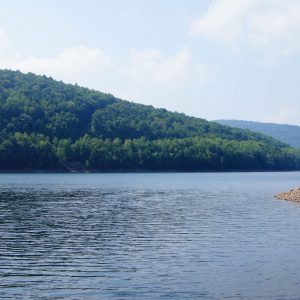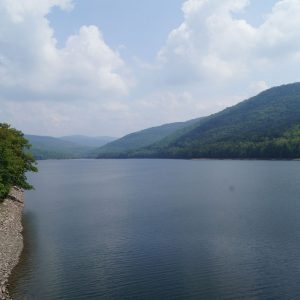The Pepacton Reservoir, also known as the Downsville Reservoir or the Downsville Dam, is a reservoir in Delaware County, New York that was formed by impounding over ¼ of the East Branch of the Delaware River.
New York City purchased the valley in 1942, displacing 974 people, destroying four towns (Arena, Pepacton, Shavertown and Union Grove), and submerging nearly ½ of the Delaware and Northern Railroad in the process. The dam, located at Downsville, was finished in 1954, and the flooding was completed in 1955.
Peapackton is a Lenape Native American term meaning “marriage of the waters”.
The reservoir is 12 miles (19 km) south of the village of Delhi and is 101 miles (163 km) northwest of New York City. The reservoir is a narrow, winding reservoir that is 15 miles (24 km) long and about 0.7 miles (1.1 km) across at its widest point. The reservoir contains 430,256 acre feet (530,713,000 m3) of water at full capacity, and is over 160 feet (49 m) deep at maximum. This makes it NYC’s biggest reservoir by volume.
The Pepacton Reservoir supplies New York City with nearly 25% of its drinking water. The water flows through the reservoir, and then empties into the 25.5-mile (41.0 km) East Delaware Tunnel near the former site of Pepacton. The water travels through the aqueduct into the Rondout Reservoir, and empties into the 85-mile (137 km) Delaware Aqueduct. The water then flows into the Kensico Reservoir just north of The Bronx.
The reservoir is a significant factor in the local economy of Downsville, New York, as thousands of tourists travel to Downsville each year to fish for trout. No motor boats are allowed on the reservoir. Source: Wikipedia




